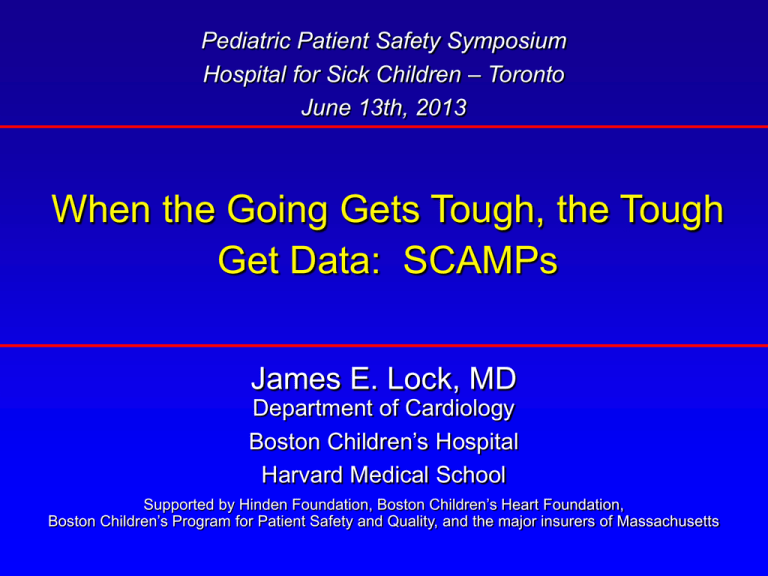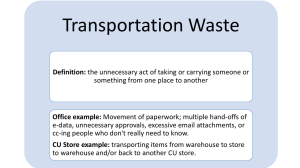When the Going Gets Tough, the Tough Get Data: SCAMPs
advertisement

Pediatric Patient Safety Symposium Hospital for Sick Children – Toronto June 13th, 2013 When the Going Gets Tough, the Tough Get Data: SCAMPs James E. Lock, MD Department of Cardiology Boston Children’s Hospital Harvard Medical School Supported by Hinden Foundation, Boston Children’s Heart Foundation, Boston Children’s Program for Patient Safety and Quality, and the major insurers of Massachusetts Declaration of Disclosure Boston Children’s Hospital is a member of the not-forprofit entity Institute for Relevant Clinical Data Analytics. The Institute has created a multi-institutional network to create and develop standardized clinical assessment and management plans (SCAMPs) around the country, and plans to license SCAMPs and related technology and services. It is possible that, in the future, Boston Children’s Hospital and SCAMP authors will receive royalties from SCAMPs. James E. Lock, MD. Learning Objectives 1. To understand the novel components behind the SCAMP process 2. To understand how the iterative SCAMP process can lead to improved clinical outcomes while identifying unnecessary resource utilization 3. To show how SCAMPs are similar and, more importantly, different than retrospective studies, clinical practice guidelines and prospective trials Why is this Important? • The increase in medical expenditures seems to be outstripping both the health benefits and the nation’s financial underpinning to pay 22% $2 00 21% Gross Dom estic Product 5,0 00 Health Care in 2018: • $4.4 Trillion in spending • >20% of the GDP $1 0,0 00 Cost (in billions) $1 20% 19% 18% $5 17% ,00 0 16% $0 Percentage of GDP spent on Health Care 0,0 National Health Care Spending 15% 2003 2004 2005 2006 2007 2008 2009 2010 2011 2012 2013 2014 2015 2016 2017 2018 Data from the Centers for Medicare and Medicaid Services Why is this Important Now? • What are the options for reducing medical expenditures? 1. Reduce salaries 2. Improve efficiency for necessary care 3. Reduce unnecessary utilization 4. Ration health care What do we currently use in clinical medicine to standardize and improve care? 1. Best clinical judgment 2. Clinical Practice Guidelines: a care plan created by experts, intended to be followed until further notice 3. Registries or Retrospective Studies: careful look backwards 4. Prospective Randomized Controlled Trials: Meant to provide a definitive and final answer Current Practice • 10 Cardiologists (7 different fields) were shadowed with every significant clinical decision recorded and classified Results – All Decisions (n = 1188, ~170 decisions/person/day) # Decisions % of Total • Experience or anecdote 441 37.1% • Arbitrary or instinct 175 14.7% • Trained to do it 173 14.6% • First principles 146 12.3% • General research study 146 12.3% • Limited research study 61 5.1% • Specific research study 34 2.9% • Parental preference 6 0.5% • For research 4 0.3% • Avoid a lawsuit 2 0.2% • Despite the “limited” nature of decision-making in pediatric cardiology, over 18 years, death from 4 “common” defects fell 2.5 fold Deficiencies of Clinical Practice Guidelines • Mandated CPGs that have been shown to be “wrong” by subsequent data1 – Tight control of glucose in ICU – Normal glucose levels in outpatients – Recommendations for hip & knee replacements – Best practices in treatment of congestive heart failure – Statins in renal failure patients on dialysis – Outpatient treatment of asthma and hypertension – Antibiotics within 4 hours of ER visit for pneumonia • Adherence to a pediatric asthma CPG was The New York Review, January 2010 between 39% and 53%2 Groopman, Cabana, Arch Pediatr Adolesc Med, Sept 2001 1 2 Conflicts of Interest for Guideline Authors Research Overall Grants Non-industry Speaker Expert OwnershipConsultant research / Advisory (industry) Honoraria Witness Interest support Board Percent with disclosures 82.4% 55.9% 29.4% 20.6% 5.9% 5.9% 50% Percent with significant financial relationship 17.6% 14.7% 5.9% 2.9% 0% 2.9% 8.8% Percent with no financial benefit, or benefit is not industry related 17.6% 44.1% 100% 79.4% 79.4% 94.1% 50% This table shows the percentages and breakdown of financial relationships for guideline committee members who participated in writing ACCF/AHA clinical guidelines in 2010 Source: CardioSource WorldNews Randomized Controlled Trials Superior Intervention Outcome 1 Management 1 Standardized Entry Criteria, Assessment, & Management (Preferred outcome) Management 2 Outcome 2 ? ? ? RCT’s only provide answer for a few patients and for only 1 or 2 outcomes during a short time period. Even then are they correct? ? Outcome 3 (Not measured) Unnecessary ? Resource Utilization Generalization of Results? Duration of RCT “Validity” , usually new RCTs What About the Gold Standard? of RCTs Summary of the Status Quo • We make most medical decisions based on instinct, anecdotes, first principles, or training • Current tools are demonstrably inadequate to handle the fact that medicine is changing constantly Shojania et al. Ann Internal Med 2007 Standardized Clinical Assessment and Management Plans: SCAMPs First Principles for SCAMPs: 1. There is no such thing as “best” practice… only sound practice that is constantly changing. 2. Very few decisions are informed by conclusive data… which are hard to acquire and often incorrect. Changes should be made on persuasive data. 3. Data collection should be targeted based on prior probabilities… but not so narrowly that important, unplanned consequences are missed. 4. Diversions are permitted… but the reasons must be recorded. These diversions will accelerate improvement. Unlike a CPG, a SCAMP is a care plan created by clinicians intended to continuously improve and promote innovation SCAMPs Knowledge or Innovation Based Diversion “Evidence” Based Standard Assessment & Management Predicted Outcome Unexpected Outcome Data analysis and frequent (q 6 month) literature review allows for SCAMP modification and improvement Unnecessary Resource Utilization Selected Information Captured In All Categories SCAMPs History • 2006: Effort begun to establish CPGs for outpatient assessment and management of several conditions • 2007: Realization that nearly all recommendations for the CPG would be arbitrary or anecdotal • 2008: Recognition that SCAMP-like activities have been very successful in past improvements in care, creation, and modification of SCAMP prototypes • 2009: Finalization of the SCAMP approach, creation of 7 SCAMPs, development of data collection tools, at Boston Children’s Hospital. First patient enrolled in March 2009 • 2010: First analysis of SCAMP data with subsequent SCAMP improvement • 2011: Spread of SCAMPs to multiple sites, including BWH SCAMPs and Research • The care plan is carefully crafted to be within the boundaries of "standard of care" and only data relevant to clinical care are captured • Analysis conducted with the intent of informing, improving, and streamlining the health care delivery process and therefore qualifies as quality improvement • Retrospective data analysis with the intent of producing generalizable knowledge comprises human subject research and therefore requires IRB approval when undertaken Adult Acute Kidney Injury SCAMP Algorithm Pediatric SCAMPs in Current Use Total number of pediatric SCAMPs: 43 • • • • • • • • • • • • • • • • • • • • • • Airway Disorders Aortic Regurgitation Aortic Stenosis AS for Cath Lab Arterial Switch Operation Aspiration Pneumonia Blood Ordering/Cell Salvage Chest Pain Coarctation Cognitive and Headache Management Critical Asthma Cytomegalovirus Prevention Dilated Aorta Distal Radius Fracture ECMO Anticoagulation Fever of Unknown Origin Food Challenge Hypertrophic Cardiomyopathy Hyperparathyroidism Immune Thrombocytopenia Interstage Single Ventricle Lipid Management • • • • • • • • • • • • • • • • • • • • • Lipid PCP Lymphatic Malformations MS/AA Myocarditis Neonatal PDA Nutrition Operative Management of TOF/PS Orthodontic Retention Papilledema PICC Line Placement Polycystic Ovarian Syndrome PPHN Pressure Ulcer Sedated Echo Sedation and Analgesia for Ventilated Pts Skin Abscess Small PDA Somatoform disorders Syncope Ureterocele Wolff–Parkinson–White syndrome Adult SCAMPs in Current Use • Total number of adult SCAMPs: 6 • Examples include: – Distal radius fracture – Acute kidney injury – Breast reconstruction post mastectomy – Inpatient management of low probability of acute coronary syndrome – Lumbar spine fusion – Discharge management of CHF exacerbations Total Patient Encounters at Boston Children’s Total of 30,922 encounters (on 11,732 patients) as of 5/1/2013 The First SCAMP (March 2009) Transposition of the great arteries after an arterial switch operation (ASO) • Background – ASO is now the preferred operation for TGA. Remaining issues include lung and coronary obstruction, a large aorta, and weakened heart muscle. Sound assessment and management is unclear. • Plausible Findings make us collect relevant data on those 4 areas of concern SCAMP Analytics and Actions: ASO First review (n=86) – O2 saturations were invariably normal Eliminated – Cardiac MRI at 12 years (n=15) yielded no new relevant clinical data Continuing to follow – Poor compliance with 6 year lipid assessment Continuing to follow Second review (n=173) – Cardiac MRI at 12 years (n=34) yielded no new relevant clinical data Use MRI for high risk patients only – Continued poor compliance with 6 year lipid assessment Eliminate – Sedated echo at 2 years (n=20) unhelpful Eliminate Third review (n=227) – No new significant cardiac findings after 6 years of age Reduce surveillance testing by 50% How often are SCAMPs followed? Chest Pain SCAMP Compliance with Testing CHB NECCA* Total ECG Recommended 357/357 (100%) 99/99 (100%) 456/456 (100%) Echo Recommended 138/177 (78%) 34/41 (83%) 171/218 (78%) Echo Not Recommended 161/180 (89%) 44/58 (76%) 205/238 (86%) 0/1 (0%) 0/0 0/1 (0%) CXR Not Recommended 338/356 (95%) 89/99 (90%) 427/455 (94%) Total Compliance 93% 90% 92% Testing Modality CXR Recommended includes Mass General Hospital, Connecticut Children’s, Baystate, Vermont Children's, Dartmouth, Harvard Vanguard, University of Massachusetts, Maine Medical Center and CHA (Worcester) *NECCA SCAMP Diversion Analysis % of All Diversions Diversion Analysis for the HCM, AS, and ASO SCAMPs What is a “Justifiable” Diversion? Example: A 1 year old presents to clinic with a PDA that is too small (diameter 1.8 mm, normal LV size) to recommend cath lab closure according to the PDA SCAMP. Patient is nonetheless referred to the cath lab for closure. I. Reasons for diversion: - Abnormal Q wave in V6 suggests significant LV volume load - LV and LA look considerably larger than RV and RA on echo. II. Findings at Cath: - Moderate (3 mm) PDA with significant shunt. II. Changes to the SCAMP: - Consider new plausible finding: LV/RV volume ratio is a better of predictor of PDA size than absolute LV size SCAMPs and Comorbidities • Aortic Stenosis and Aortic Regurgitation SCAMPs recommend no exercise restrictions • Largest diversion category for both AS and AR were providers restricting exercise (no weightlifting). Almost all cases were due to comorbidity of dilated aorta. • Important and unidentified management issues related to co-morbidities are recognized through diversion analysis and are included in revised version of SCAMPs SCAMPs Provider Experience Survey 2010 Results 2011 Results 60% How positive or negative is your opinion of SCAMPs? 60% 48% 50% 50% 41% 40% 27% 30% 30% 20% 15% 20% 10% 13% 10% 10% 0% 6% 2% 0% Very Negative Negative Neutral Positive Very Positive 0% Very Negative 2010 Results Which evidencebased method do you prefer? 37% 40% 80% 70% 60% 46% 50% 40% 30% 30% 20% 11% 13% 10% 0% 0% CPG Care Pathway Clinical Protocol SCAMP Other Negative Neutral Positive Very Positive Patient Experience Survey (Nov 2011) Claims data from a Massachusetts Insurance Company Baseline Evaluation N F/U Time (mo) N F/U Time (mo) Δ Standardized Billed Medical Charges * AR 8 69.85 5 37.01 -50% AS 6 46.74 5 32.26 11% ASO 21 133.92 14 94.03 -25% DA 24 173.68 24 152.3 -63% HCM 14 80.09 23 134.66 -28% * Per member per month Chest Pain SCAMP: Reducing Utilization • An echo is “indicated” only with chest pain on exercise % of patients with exertional CP who did not have an echo % of patients with CP exclusively at rest who had an echo 50% 50% 40% 40% 33% 30% 30% 20% 17% 29% 20% 14% 10% 10% 0% 0% His toric al C ontrol (n= 406) S C A MP P atients (n= 457) Historical Control (n=406) SCAMP Patients (n=457) • Mean patient actual care charges pre-SCAMP = $2,506/pt • Mean patient actual care charges with SCAMP = $2,068/pt • Chest Pain SCAMP has lead to ~20% reduction in actual patient care charges Catch Lab Aortic Valvuloplasty SCAMP: Improving Outcomes Ideal (AS <35 mm Hg, 0 – trace AR) Adequate (AS <35 mm Hg, mild AR) Inadequate (AS ≥ 35 mm Hg or ≥ moderate AR) Freedom from AVR at 10 years: - Ideal: ~95% - Adequate: ~80% - Inadequate: ~65% Brown et al, JACC 2011. Catch Lab Aortic Valvuloplasty SCAMP: Improving Outcomes Ideal = AS <35 mm Hg, 0 – trace AR Adequate = AS <35 mm Hg, mild AR) Inadequate = AS ≥ 35 mm Hg or ≥ moderate AR) SCAMP Benefits (to whom) • Cardiology example – 6 SCAMPs have saved $726,000 in avoided testing costs – Testing costs were estimated • 6 Cardiology SCAMPs – Direct costs savings of $510,000 • Return on investment if 42% SCAMPs Benefits for Payor • 2 SCAMPs with actual single payor cost data – ASO SCAMP: 37% reduction (vs 11% projected) – Hypertrophic cardiomyopathy SCAMP: 29% reduction (vs 20% projected) • Payor savings on these 2 SCAMPs: $149,000 (not statistically robust) • Assume this payor has a 20% market share, then BCH saves payors $745,000 on two SCAMPs – Are there savings from factors other than testings? • Return on investment if 338% (this is a major effect!) Pediatric SCAMPs Network • Boston Children’s Hospital • New England Congenital Cardiology Association (NECCA) – Harvard Vanguard – Hasbro Children’s – Baystate Medical Center – University of Mass – Connecticut Children’s MC – Mass General Hospital – Vermont Children’s Hospital – Maine Medical Center – Dartmouth Hitchcock – CHA (Worcester, MA) • Children’s Hospital of Wisconsin • Children’s National Medical Center (Washington, DC) • University of California San Francisco • Stanford • Pediatric Endocrine Society • Hospital for Sick Kids (Toronto, Canada) • Great Ormond Street (London, United Kingdom) Adult SCAMPs Network • Brigham Women’s Hospital • Lancaster General Hospital How Will SCAMPS Become an Ongoing, Integral Part of Medical Care? 1. Institute for Relevant Clinical Data Analytics established as 501c3 non-profit in 2010 2. Formal Members: Boston Children’s Hospital, Brigham and Women’s Hospital, Children’s Hospital of Wisconsin, Children’s National Medical Center (Washington D.C.), Lancaster General Hospital, Pediatric Endocrine Society, NECCA, Toronto Sick Kids 3. Institutions reviewing contract: Stanford, Sydney Children’s Hospital (Australia) How Will SCAMPS Become an Ongoing, Integral Part of Medical Care? 4. Products: a. SCAMP content itself b. Consulting services to help others write and implement SCAMPs c. Data generated from SCAMP and modifications based on that data d. Software programs e. Data related to but not directly derived from SCAMPs (i.e., diversion analyses) f. Use of SCAMPs for MOC credit Current Finances of SCAMPs Impact on Benefit Creators (Provider Institutions / Doctors) 1. 2. 3. 1. Reduced revenue from reduced unnecessary 2. care Increased costs to $$$ collect and analyze data to further reduce unnecessary care 3. Decreased margin, because unnecessary care is the most profitable care Impact on Benefit Recipients Payers Patients – Better care – Reduced co-pays – Less time waiting for unnecessary care Employers – Healthier workers – Reduced premiums Conclusions and Next Steps • SCAMPs have successfully and repeatedly, in a variety of conditions and locations: – Reduced practice variation – Iteratively optimized care – Reduced unnecessary utilization • SCAMPs build on key principles well-known to clinicians, permit diversions, and use data to improve care delivery • SCAMPs create natural networks to rapidly and collaboratively improve care delivery • Expansion of SCAMPs IT support and network is rapid and inevitable, but will require careful planning








